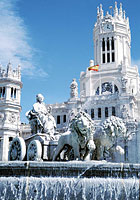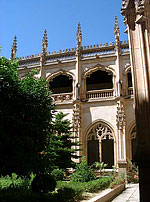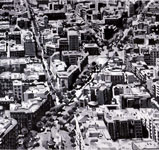| |
 |
| Welcome
to Madrid it Vortal City Network |
 |
|
| Madrid
- Online Hotel reservation |
|
Madrid has been the first city of Spain
for almost 5 centuries, ever since a resolute
King decided to take his entire court
to a modest burg at the Manzanares river
bank. From this time, Madrid has consolidated
it fundamental role and has become a Spanish
political and financial centre, as well
as one of the liveliest cities in Europe
with regards to culture and the arts.
Located at the heart of the Castilian
planes and of Spain itself, Madrid is
the starting point to the discovery of
the entire country, not only because of
the "Puerta Del Sol" (the Gate to the
Sun) from and to all distances in Spain
are measured, but also because it embodies
the flavors and traditions of the entire
nation. Madrid and its 3 million inhabitants
-that become 5 millions if the entire
province of Madrid is considered- are
the protagonists of the eternal spark
that characterizes the live of this cosmopolitan
city; after the "delirio" of the Franco
years, the city has once again conquered
its equilibrium, and it has established
its image to the eyes of the tourist,
still enchanted by the enthusiastic nightlife
of its streets, squares, and bars.
Appealed by the entertainment and surrendered
to the scent of art that is breathed at
the prestigious museums of the "Paseo
del Prado", the number of visitors of
Madrid grows every year. They have not
cancelled their rendezvous with the Spanish
capital even after the events of March
the 11 th 2004 , admired by the braveness
of the Spanish people and by their firm
reaction to terrorism.
|
|
 |
|
|
|
|
Madrid 's history
goes back to a relatively
recent time and it
is closely connected
to the Muslim world.
In 865 A.D. Mohamed
I decided to build
a fort on the current
site of the Spanish
capital, which he
named Magrit. This
strategic position
at the Manzanares
River bank and at
the centre of the
Meseta exposed the
settlement to frequent
conflicts between
Christians and Muslims
until the arrival
of Alfonso IV of Castilla
at the beginning of
the eleventh century.
The first attempt
to position Madrid
as an important city
was made by Isabella
of Castilla and Ferdinand
of Aragona, but it
is Phillip II who
changed the faith
of the city when he
named it the capital
of the empire.
|
 |
|
 |
After a period in which Madrid
remained of modest size, the
city exploded and reached
its Culturel and political
peak with Phillip IV. This
is the period of the Spanish
Baroque and of the great master
Diego Velazquez.
With the coming of the Bourbons
and the arrival to the throne
of the Francophile Carlo II
the city changed its face
and grew richer of new architectural
marvels; the 1800's are also
the years of the Spanish rebellion
to the TRANSALPINI domination
and of the successive cruel
Napoleonic repression.
|
If
the nineteenth century was unstable,
the twentieth century was for
Madrid even more tragic. The
three years of Civil War (1936
- 1939) left its mark in the
capital, and the control of
the General Franco, which lasted
until 1975, clouded the image
of the city.
The arrival
of the young King Juan Carlos
of Bourbon has brought to Madrid
a period of innovation. The
Spanish capital has become the
capital of the "movida," a centre
of famous museums of immense
value and one of the most desirable
destinations of international
tourism. |
| |
|
|
|
|
| |
|
| |
|
|
 |
|